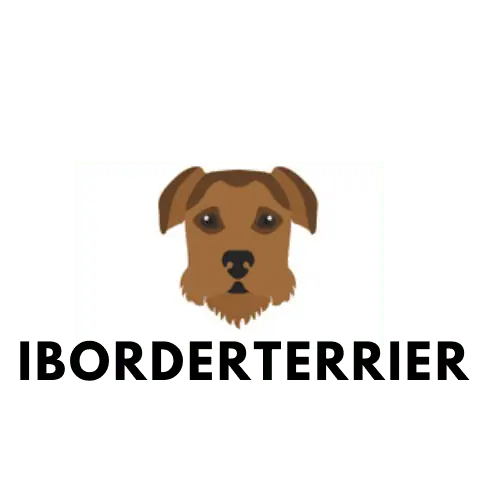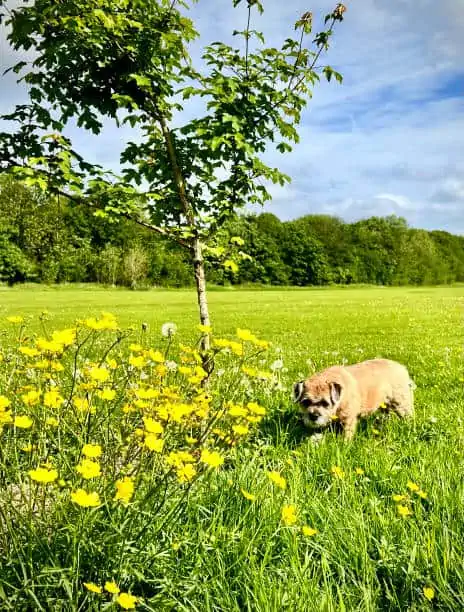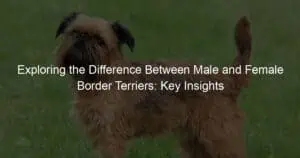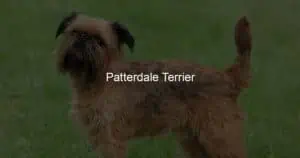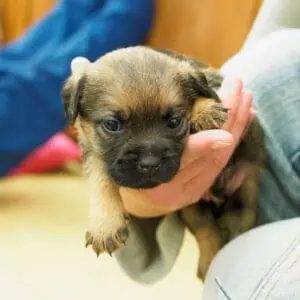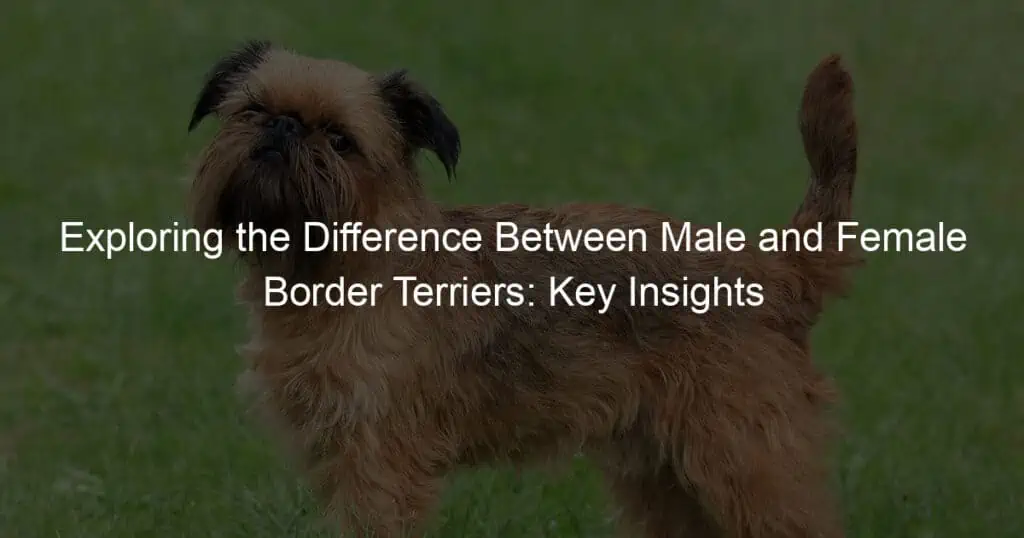When it comes to choosing a canine companion, there are a seemingly infinite number of options to choose from. Two popular choices are Border Terriers and Norfolk Terriers. So, which one among border terrier vs norfolk terrier is the right breed for you?
Both are compact dogs with short legs and long bodies. They are also similar in terms of energy level, intelligence, and playfulness. However, there are some key differences between the two breeds.
About Border Terrier
The Border Terrier is a small, working terrier of the foxhound type. In addition to the Dandie Dinmont Terrier and Bedlington Terrier, the Border Terrier has ancestry with the Border Collie. It was traditionally used for hunting foxes by trailing them to their dens, and occasionally going to ground after them, although this activity is now illegal in many countries.
In 1920, the Kennel Club in Great Britain and in 1930, the American Kennel Club recognized the Border Terrier.
They have a flat head with a moderate stop; their ears are V-shaped and fold forward close to the head. Their teeth meet in a scissors bite. The nose is black. The almond-shaped eyes are dark brown. Their neck is strong and of medium length. The body is slightly longer than it is tall. The legs are straight with small, round feet. The dewclaws may be removed. The tail is medium in length, tapering to a point, and carried erect.
The dense, wiry coat may be wheaten (light brownish-yellow), grizzle and tan (a mix of grey, brown, and black hairs), blue and tan, or red. Black and tan are not allowed in show dogs in the United States but are common in working dogs.
Another Interesting Read: Are Border Terriers Good Apartment Dogs?
About Norfolk Terrier
The Norfolk Terrier is a small terrier breed originating in the county of Norfolk, England. It is a wire-haired breed and one of the smallest of the working terriers. The coat is hard, dense, and wiry; it may be black and tan, grizzled, and tan, red, or wheaten. The ears fold over at the tips. The Norfolk Terrier breeds are affectionate dogs and a relative of the Norwich Terrier, and in 1932 the Kennel Club merged the two breeds, permitting interbreeding. In America, however, the American Kennel Club maintained the distinction between the two.
The Norfolk Terrier was used for rat-catching in stables and farms, and for hunting small vermin. It is an active and hardy breed, still used for hunting in some parts of the world.
The ideal height of a Norfolk Terrier at the withers is 10 inches (25 cm), although some may be slightly larger or smaller.
The Norfolk Terrier dog breed has a small, compact body. The head is slightly longer than it is wide, with a strong muzzle and teeth that meet in a scissors bite. The eyes are small and dark, set fairly far apart.
The ears are V-shaped and drop down close to the head. The neck is of medium length, and from withers to rump, the topline slopes slightly. The chest is deep, and the ribs are well-sprung. The legs are straight and of medium bone, with small, compact feet. The tail is customarily docked to two-fifths of its original length.
Another Interesting Read: When To Breed a Border Terrier?
Border Terrier Vs Norfolk Terrier-Point Of Differences
The Border Terrier and the Norfolk Terrier are two breeds of dogs that are often confused with each other. Though they may look similar, there are some key differences between these two breeds.
1. Size
One of the most obvious differences between the Border Terrier and the Norfolk Terrier is their size. The Border Terrier is a medium-sized dog, weighing in at 11-15 pounds and standing 11-14 inches tall at the shoulder. The Norfolk Terrier, on the other hand, is a small breed, weighing in at 10-12 pounds and standing 9-10 inches tall at the shoulder.
2. Coat
Another difference between these two breeds is their coat. The Border Terrier has a double coat, consisting of a rough, outer coat and a soft, dense undercoat. The Norfolk Terrier also has a double coat, but its outer coat is not as rough as the BorderTerriers.
Another Interesting Read: How Much Water Does A Border Terrier Need?
3. Shedding
Because of their difference in coat, these two breeds also differ in how much they shed. The Border Terrier sheds a moderate amount, while the Norfolk Terrier sheds very little.
4. Head
When it comes to their head, the Border Terrier has a slightly longer head than the Norfolk Terrier, with a muzzle that is equal in length to their skull. The Norfolk Terrier has a shorter head, with a muzzle that is shorter than its skull.
5. Ears
Another difference between these two breeds is their ears. The Border Terrier has V-shaped ears that are medium in size and lay close to their head. The Norfolk Terrier has small, button-shaped ears that stand erect on its head.
6. Tail
The tail of the Border Terrier is medium in length and tapers to a point. The Norfolk Terrier has a short, blunt tail that is often described as being “stumpy.”
7. Build
When it comes to their build, the Border Terrier is a long and low dog, while the Norfolk Terrier is more compact.
8. Exercise Needs
The Border Terrier and the Norfolk Terrier have different exercise needs. The Border Terrier is a high-energy breed that needs a lot of exercises, while the Norfolk Terrier is a low-energy breed that is content with a moderate amount of exercise.
9. Temperament
Another difference between these two breeds is their temperament. The Border Terrier is an independent and willful breed, while the Norfolk Terrier is more easygoing and people-oriented.
Another Interesting Read: How Many Puppies Do Border Terriers Have
10. Grooming Needs
When it comes to grooming, the Border Terrier and the Norfolk Terrier have different needs. The Border Terrier needs to be brushed two to three times a week and its coat should be clipped every few months. The Norfolk Terrier only needs to be brushed once a week and its coat does not need to be clipped.
Despite their similarities, the Border Terrier and the Norfolk Terrier are two distinct breeds. When choosing between these two breeds, it is important to consider your lifestyle and needs to find the best fit for you.
ALSO READ:
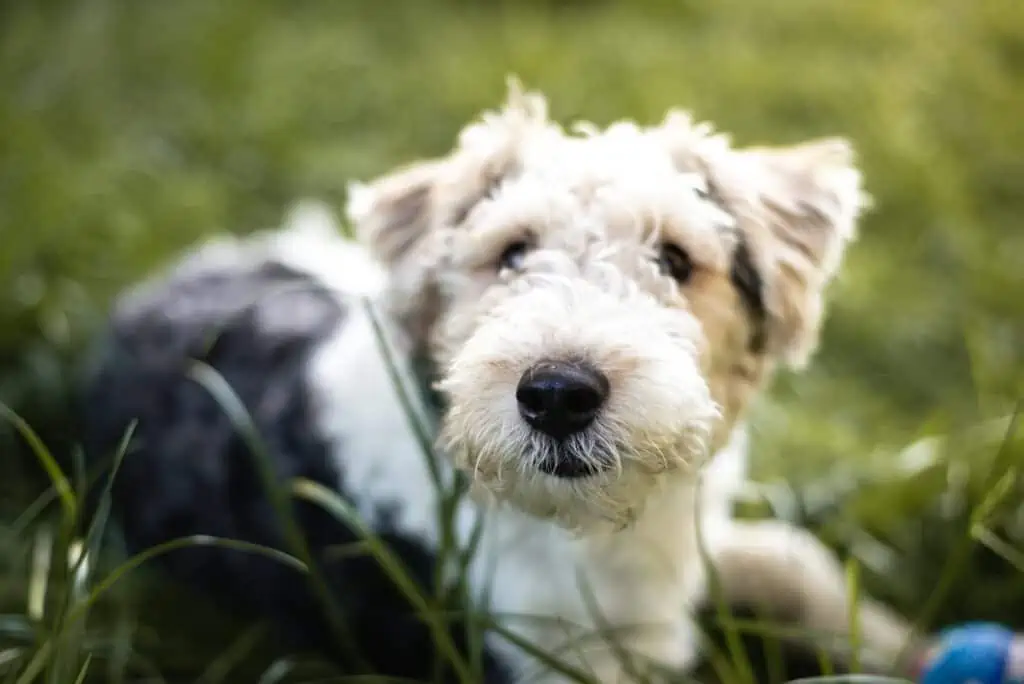
A Comparison of Appearance and Size Between Border Terriers and Norfolk Terriers
The table below provides a concise comparison of the appearance and size differences between Border Terriers and Norfolk Terriers. These two terrier breeds have distinct physical characteristics that set them apart. Understanding their appearances and size variations can help potential owners make informed decisions based on their preferences.
| Terrier Breed | Appearance | Size |
|---|---|---|
| Border Terrier | Compact, muscular build | Height: 10-11 inches |
| Moderately broad head, dark eyes | Weight: 11.5-15.5 pounds | |
| Medium-sized, forward-folded ears | ||
| Weather-resistant double coat | ||
| Common coat colors: grizzle and tan, | ||
| blue and tan, or red | ||
| Norfolk Terrier | Compact, sturdy build | Height: 9-10 inches |
| Broad, slightly rounded head | Weight: 11-12 pounds | |
| Small, forward-folded drop ears | ||
| Straight, wiry outer coat | ||
| Common coat colors: red, wheaten, | ||
| black and tan, or grizzle |
Temperament and Personality Between Border Terriers and Norfolk Terriers
The table below provides a side-by-side comparison of the contrasting personality traits and temperaments of Border Terriers and Norfolk Terriers. While both breeds share some common terrier characteristics, they also possess unique qualities that set them apart. Understanding their temperaments can help prospective owners choose the breed that best aligns with their lifestyle and preferences.
| Personality | Border Terrier | Norfolk Terrier |
|---|---|---|
| Affectionate | Yes | Yes |
| Playful | Yes | Yes |
| Energetic | Yes | Yes |
| Independent | Yes | Yes |
| Intelligent | Yes | Yes |
| Curious | Yes | Yes |
| Confident | – | Yes |
| Fearless | – | Yes |
| Loyal | – | Yes |
| Watchful | – | Yes |
| Prey Drive | – | Strong |
| Good with Children | Yes | Yes |
| Good with Pets | Yes | Yes |
Exercise and Activity Levels Between Border Terriers and Norfolk Terriers
Regular exercise is essential for the overall health and well-being of dogs. When comparing Border Terriers and Norfolk Terriers, it’s important to consider their exercise requirements and energy levels to ensure they receive adequate physical activity. Here’s a closer look at the exercise needs of each breed:
| Border Terrier | Norfolk Terrier | |
|---|---|---|
| Exercise Requirements | Moderate | Moderate |
| Energy Level | Moderate | Moderate |
| Daily Exercise | 30-60 minutes | 30-60 minutes |
| Activities | Walks, Playtime, Mental Stimulation | Walks, Playtime, Mental Stimulation |
Both Border Terriers and Norfolk Terriers have moderate exercise requirements and energy levels. They benefit from daily exercise sessions that include walks, playtime, and mental stimulation. These activities not only provide physical exercise but also help to fulfill their mental and behavioral needs.
It is recommended to provide 30-60 minutes of exercise per day for both breeds. This can be achieved through walks around the neighborhood, interactive play sessions, and engaging them in mentally stimulating activities such as puzzle toys or obedience training. However, it’s important to note that individual exercise needs may vary depending on factors such as age, health, and overall fitness level.
Proper exercise not only helps to maintain a healthy weight but also promotes mental stimulation, prevents boredom, and reduces the risk of behavioral issues. It is important to create a balanced exercise routine that suits the individual needs of your Border Terrier or Norfolk Terrier.
Always consider the specific needs and limitations of your dog when planning exercise activities. Consulting with a veterinarian or professional dog trainer can provide additional guidance on developing an exercise regimen that best suits your dog’s needs and ensures they remain happy, healthy, and well-exercised.
Grooming and Coat Care Between Border Terriers and Norfolk Terriers
Proper grooming is essential to keep dogs looking their best and maintaining the health of their coat. When comparing Border Terriers and Norfolk Terriers, it’s important to consider their grooming requirements and coat types. Here’s a closer look at the grooming needs of each breed:
| Grooming | Border Terrier | Norfolk Terrier |
|---|---|---|
| Coat Type | Double Coat: Harsh, dense outer coat with | Double Coat: Straight, wiry outer coat |
| a soft undercoat | ||
| Grooming Requirements | Moderate | Moderate to High |
| Shedding | Low | Low |
| Trimming | Occasional hand-stripping or clipping for | Hand-stripping or professional grooming |
| coat maintenance | may be required | |
| Brushing | Weekly brushing to remove loose hair and | Regular brushing to prevent matting and |
| prevent matting | maintain coat condition | |
| Bathing | Infrequent bathing to maintain coat health | Infrequent bathing to maintain coat health |
Border Terriers and Norfolk Terriers both have double coats, but there are slight differences in their textures. Border Terriers have a harsh, dense outer coat with a soft undercoat, while Norfolk Terriers have a straight, wiry outer coat. Both breeds have low shedding, making them suitable for individuals with allergies or those who prefer a cleaner home.
Grooming requirements for both breeds are moderate, with occasional hand-stripping or clipping necessary to maintain the coat’s texture and appearance. Regular brushing is essential to remove loose hair, prevent matting, and keep the coat in good condition. Additionally, infrequent bathing is recommended to preserve the natural oils in the coat and prevent skin dryness.
For Norfolk Terriers, hand-stripping may be required to maintain the texture of the wiry coat. This process involves removing dead hairs by hand to promote new hair growth and maintain the desired appearance. Some Norfolk Terrier owners opt for professional grooming services to ensure the coat is properly hand-stripped.
It’s important to establish a regular grooming routine for both breeds to keep their coats healthy and prevent any discomfort or matting. Consulting with a professional groomer or breed-specific resources can provide further guidance on the specific grooming needs of Border Terriers and Norfolk Terriers.
Compatibility with Families and Children
| Border Terrier | Norfolk Terrier | |
|---|---|---|
| Affectionate towards Family | Yes | Yes |
| Playfulness | Yes | Yes |
| Good with Children | Yes | Yes |
| Patience with Children | Yes | Yes |
| Tolerance for Rough Play | Moderate | Moderate |
| Adaptability to Family Routine | High | High |
| Protective Instinct | Moderate | Moderate |
| Compatibility with Other Pets | Yes | Yes |
Both Border Terriers and Norfolk Terriers are known to be affectionate and playful with their families, making them excellent choices for families with children. They generally have a good tolerance for children and display patience in their interactions. However, it is important to note that supervision is always recommended when young children are interacting with any dog breed to ensure both the child and the dog’s safety.
Border Terriers and Norfolk Terriers adapt well to family routines and thrive in an environment with consistent schedules and structured activities. They can easily become a beloved part of the family dynamic and enjoy participating in family activities.
While these breeds are generally good with children, it is crucial to teach children how to properly interact with dogs, including being gentle and respectful. Additionally, it’s important to socialize your dog with children and provide positive experiences to foster a strong bond and a harmonious relationship.
Both Border Terriers and Norfolk Terriers tend to get along well with other pets, making them suitable for households with existing animals. However, proper introductions and gradual acclimation are recommended to ensure a smooth integration.
Always remember that individual dogs within each breed can vary in temperament and behavior. It’s important to spend time with individual dogs and consult reputable breeders or experienced owners to gain a better understanding of each breed’s compatibility with families and children.
By considering their temperament, adaptability, and compatibility with children and other pets, you can make an informed decision about whether a Border Terrier or a Norfolk Terrier is the right fit for your family.
Final Words:
As you can see, there are some key differences between the Border Terrier and the Norfolk Terrier. Though they may look similar, these two breeds are quite different in many ways. When it comes to choosing a breed of dog, it’s important to do your research to make sure you’re choosing the right one for you and your lifestyle.
